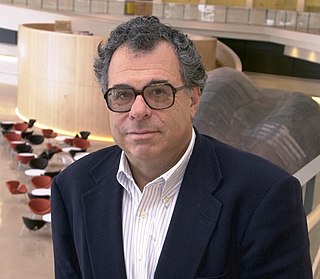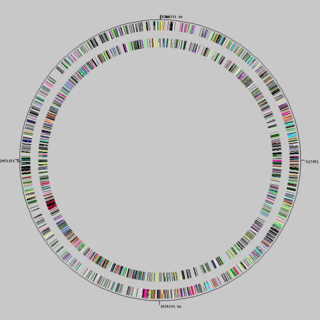
Saccharomyces cerevisiae is a species of yeast. The species has been instrumental in winemaking, baking, and brewing since ancient times. It is believed to have been originally isolated from the skin of grapes. It is one of the most intensively studied eukaryotic model organisms in molecular and cell biology, much like Escherichia coli as the model bacterium. It is the microorganism behind the most common type of fermentation. S. cerevisiae cells are round to ovoid, 5–10 μm in diameter. It reproduces by budding.
Leland Harrison (Lee) Hartwell is former president and director of the Fred Hutchinson Cancer Research Center in Seattle, Washington. He shared the 2001 Nobel Prize in Physiology or Medicine with Paul Nurse and Tim Hunt, for their discoveries of protein molecules that control the division (duplication) of cells.

Franklin (Frank) William Stahl is an American molecular biologist and geneticist. With Matthew Meselson, Stahl conducted the famous Meselson-Stahl experiment showing that DNA is replicated by a semiconservative mechanism, meaning that each strand of the DNA serves as a template for production of a new strand.

David Botstein is an American biologist who is the chief scientific officer of Calico. He was the director of the Lewis-Sigler Institute for Integrative Genomics at Princeton University from 2003 to 2013, where he remains an Anthony B. Evnin Professor of Genomics.
The Ty5 is a type of retrotransposon native to the Saccharomyces cerevisiae organism.

The mobilome is the entire set of mobile genetic elements in a genome. Mobilomes are found in eukaryotes, prokaryotes, and viruses. The compositions of mobilomes differ among lineages of life, with transposable elements being the major mobile elements in eukaryotes, and plasmids and prophages being the major types in prokaryotes. Virophages contribute to the viral mobilome.
Virginia Zakian is the Harry C. Wiess Professor in the Life Sciences in the Department of Molecular Biology at Princeton University. She is the director of the Zakian Lab, which has done important research in topics such as telomere-binding protein, telomere recombination, and telomere position effects, at Princeton University. She is a fellow at the American Academy of Microbiology and the American Association for the Advancement of Science., and is an elected member of the National Academy of Sciences (2018). Zakian served as the chair of "Princeton's Task force on the Status of Women Faculty in the Natural Sciences and Engineering at Princeton" from 2001-2003, in 2003 Zakian became Princeton University's representative to Nine Universities, Gender Equity Analysis She was elected as a member of the American Academy of Arts and Sciences in 2019.
Ira Herskowitz was an American phage and yeast geneticist who studied genetic regulatory circuits and mechanisms. He was particularly noted for his work on mating type switching and cellular differentiation, largely using Saccharomyces cerevisiae as a model organism.
Gerald Ralph Fink is an American biologist, who was Director of the Whitehead Institute at MIT from 1990–2001. He graduated from Amherst College in 1962 and received a Ph.D. from Yale University in 1965, having elucidated the histidine pathway in budding yeast, Saccharomyces cerevisiae. After postdoctoral study at the National Institutes of Health with Bruce Ames on the regulation of the histidine operon of Salmonella, in 1967 he joined Cornell University where he became a Professor of Genetics and pursued the study of the HIS4 region of yeast. In 1982 he became a founding member of the Whitehead Institute and Professor of Genetics at MIT. Dr. Fink was elected to the United States National Academy of Sciences in 1981, to the Institute of Medicine in 1996, and to the American Philosophical Society in 2003.

Genome evolution is the process by which a genome changes in structure (sequence) or size over time. The study of genome evolution involves multiple fields such as structural analysis of the genome, the study of genomic parasites, gene and ancient genome duplications, polyploidy, and comparative genomics. Genome evolution is a constantly changing and evolving field due to the steadily growing number of sequenced genomes, both prokaryotic and eukaryotic, available to the scientific community and the public at large.
Nir Friedman is an Israeli Professor of Computer Science and Biology at the Hebrew University of Jerusalem.
Saccharomyces kudriavzevii, is a species of yeast in the Saccharomyces sensu stricto complex. Its type strain is NCYC 2889T. It is used in production of alcoholic beverages, including pinot noir wine, and hybrids of it are used in beer brewing. It is isolated widely from the bark of oak trees.

Leona D. Samson is the Uncas and Helen Whitaker Professor and American Cancer Society Research Professor of Biological Engineering at the Massachusetts Institute of Technology, where she served as the Director of the Center for Environmental Health Sciences from 2001 to 2012. Before her professorship at MIT, she held a professorship at the Harvard School of Public Health. She is on the editorial board of the journal DNA Repair. Her research interests focus on "methods for measuring DNA repair capacity (DRC) in human cells", research the National Institute of Health recognized as pioneering in her field, for which the NIH granted her the National Institutes of Health Director's Pioneer Award.

Fred Sherman was an American scientist who pioneered the use of the budding yeast Saccharomyces cerevisiae as a model for studying the genetics, molecular biology, and biochemistry of eukaryotic cells. His research encompassed broad areas of yeast biology including gene expression, protein synthesis, messenger RNA processing, bioenergetics, and mechanisms of mutagenesis. He also contributed extensively to the genetics of the opportunistic pathogen Candida albicans.
SilentInformationRegulator (SIR) proteins are involved in regulating gene expression. SIR proteins organize heterochromatin near telomeres, ribosomal DNA (rDNA), and at silent loci including hidden mating type loci in yeast. The SIR family of genes encodes catalytic and non-catalytic proteins that are involved in de-acetylation of histone tails and the subsequent condensation of chromatin around a SIR protein scaffold. Some SIR family members are conserved from yeast to humans.
Jef D. Boeke is an American geneticist who is currently the founding director of the Institute for Systems Genetics at NYU Langone Medical Center. From 1986 to 2014 he was on the faculty of The Johns Hopkins University School of Medicine, where he was the founding director of the High Throughput (HiT) Center. He is a member of the American Academy of Arts and Sciences as well as the National Academy of Sciences.
The Gal4 transcription factor is a positive regulator of gene expression of galactose-induced genes. This protein represents a large fungal family of transcription factors, Gal4 family, which includes over 50 members in the yeast Saccharomyces cerevisiae e.g. Oaf1, Pip2, Pdr1, Pdr3, Leu3.
Christine Guthrie (1945-2022) was an American yeast geneticist and American Cancer Society Research Professor of Genetics at University of California San Francisco. She showed that yeast have small nuclear RNAs (snRNAs) involved in splicing pre-messenger RNA into messenger RNA in eukaryotic cells. Guthrie cloned and sequenced the genes for yeast snRNA and established the role of base pairing between the snRNAs and their target sequences at each step in the removal of an intron. She also identified proteins that formed part of the spliceosome complex with the snRNAs. Elected to the National Academy of Sciences in 1993, Guthrie edited Guide to Yeast Genetics and Molecular Biology, an influential methods series for many years.
Alexander "Sandy" D. Johnson is an American biochemist and Professor and Vice Chair of the Department of Microbiology and Immunology at the University of California, San Francisco. He is a member of the U.S. National Academy of Sciences.
Benjamin Downs "Ben" Hall was an American human genetics researcher. He was professor of genetics and botany at the University of Washington. Hall is best known for developing methods for producing vaccines and other bio-pharmecuticals using transgenic yeast.







